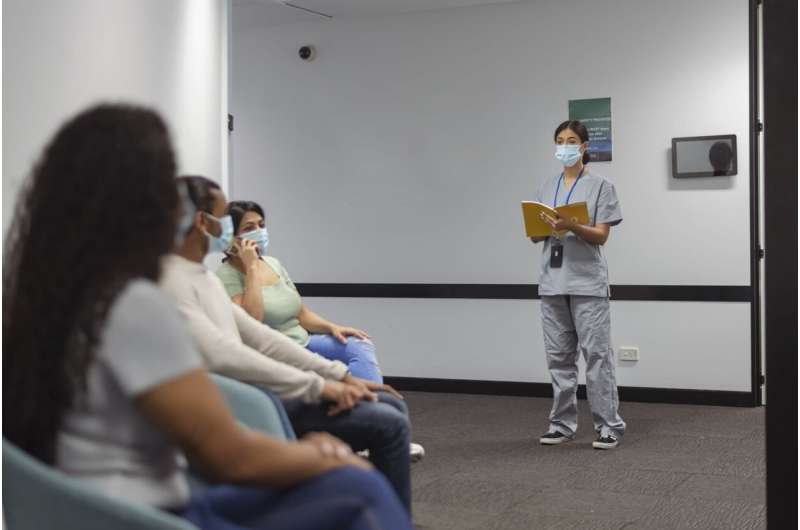This article has been reviewed according to Science X's editorial process and policies. Editors have highlighted the following attributes while ensuring the content's credibility:
fact-checked
trusted source
proofread
Opinion: In rural and remote health care, investing in the workforce isn't enough

When people talk about rural health, they often do so in deficit-based language. Much of this is because health outcome disparities across Australia's population have been extensively documented, with differences in the aggregated health status of people living in rural and metropolitan areas regularly highlighted.
"Rural" health outcomes are poorer—the solution must lie in increasing the workforce, and better distribution of health professionals in these areas.
Or does it?
We know there's maldistribution of the health workforce. Distributing the workforce so the ratio of health care providers to population (population-provider ratio, or PPR) does not, however, mean equality in health care.
The number of registered health care workers in Australia increased by more than 110,000 between 2015 and 2020 to more than 620,000 (with an unknown number of health care workers in self-regulated professions), but contemporary shortages show that simply increasing health professional graduates doesn't solve health care issues.
For example, in 2019, Queensland had the highest number of GPs per 100,000 of the population of any Australian state or territory, but this wasn't reflected in better aggregated health outcomes for the population.
More to health status than location
The health status of people living in rural areas is not homogenous, just as the health of people living in metropolitan areas varies.
Health status is more complex than just your address. At a population level, the biggest predictor of health status is the social determinants of health. These are the non-medical factors and conditions in which people live, eat, work and play, such as education, employment, housing, social support, and discrimination.
Epidemiologist Professor Michael Marmot has demonstrated the effect of the social determinants over several decades. At a population level, people living in deprived areas have poorer health and shorter life expectancies.
In contrast, people with much longer life expectancies live in communities where healthy lifestyle choices are relatively easy.
Of course, addressing these determinants of health isn't independent of providing access to quality health care, but addressing the inequitable distribution of the health workforce is not the panacea for population health inequities.
Chronic diseases have the highest burden of disease in Australia, with direct costs greater than those spent on primary care. Rates of chronic disease disproportionately affect those who have the underlying risk factors of social determinants of health.
Having one or more chronic illnesses can contribute to decreased functionality, further increasing these risk factors.
Instead of supply, why not focus on need? We know that the population who has the highest need for primary care access it the least. There are multiple factors influencing this, which include cost, travel time, and the lack of acceptable/appropriate services.
The 'inverse care law' is still in the conversation
Inversely, those who have the lowest need often have the most access, and utilize care accordingly. The "inverse care law" (that availability of good medical care tends to vary inversely with the needs of the population served) was first published 50 years ago, and continues to be discussed, particularly in relation to the influence of market forces.
We need to think "outside the box" to determine who needs care most, and how it can be delivered. The organization of health care is not a "one-size-fits-all", as is being currently discussed.
If we consider a population's needs, then the type of health care worker and the model in which they work can be nuanced. That is, within health services, resources can be directed to addressing the underlying determinants of poor health outcomes.
Examples include the work of rural nurse practitioners in the provision of health and social care, and multidisciplinary models of managing chronic illness.
A parallel focus is required
Enabling health professionals to work at the top end of their scope of practice within an integrated model of care through appropriate funding and practice models enables better utilization of practitioner skill sets, and reduces the burden on other health professionals such as GPs.
Addressing disparities in health outcomes requires a parallel focus on underlying physical, environmental and psychosocial determinants.
Health care practitioners need to become advocates for elements that improve the socioeconomic status of the population, as well as supporting health equity and justice, and advocacy practice should start formally during health professional education.
We can't continue to focus on the same disparity remedies if we expect different outcomes in health. Instead, we could implement models of social and health care with emphasis on everyone getting what they need regardless of where they live or their context, enabling health justice, and involving communities in decision-making processes.
By approaching health care through the lens of the social determinants in these ways, we'll be closer to providing the right care, at the right time, in the right place.





















